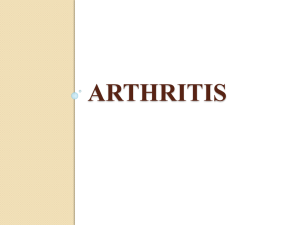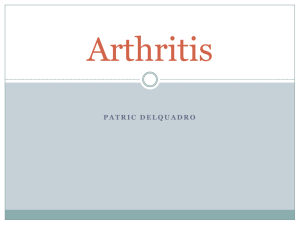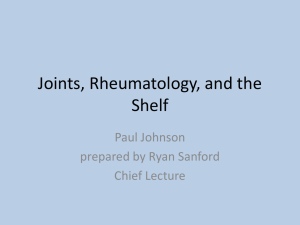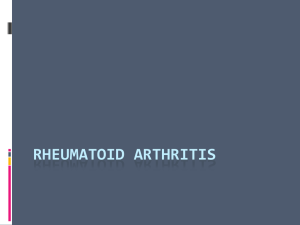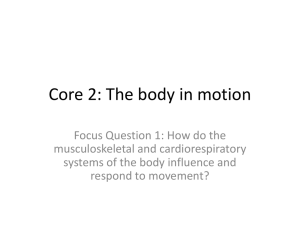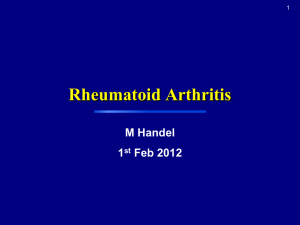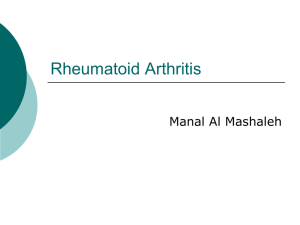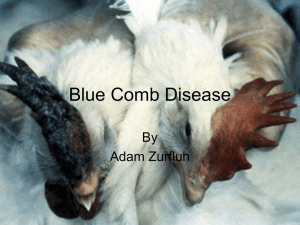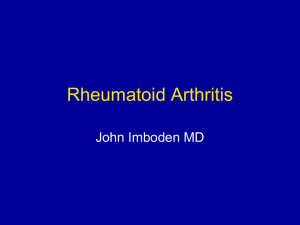Managing Flares in Psoriatic Arthritis
advertisement
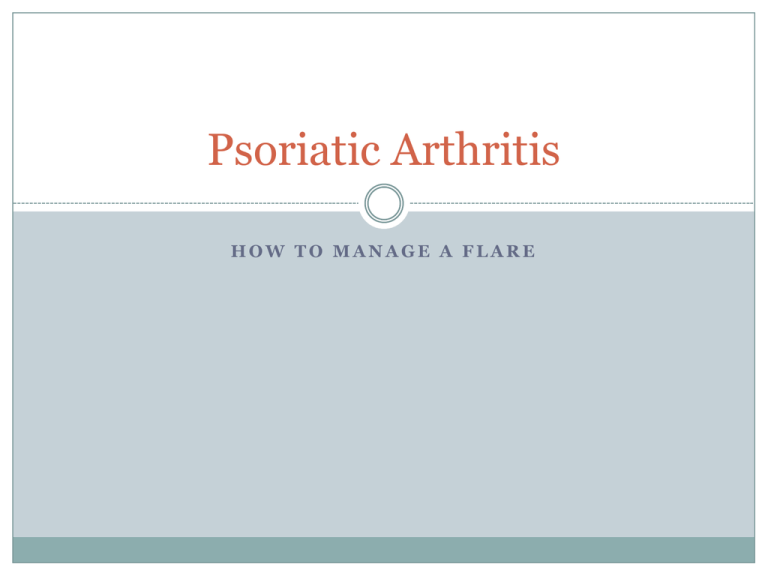
Psoriatic Arthritis HOW TO MANAGE A FLARE What is psoriatic arthritis? Psoriatic Arthritis Arthritis is inflammation of joints Psoriasis is a skin condition which causes patches or plaques of red scaly skin. Psoriatic arthritis is a type of arthritis which develops in some people with psoriasis Skin psoriasis can be severe or mild, some people just have a family history of psoriasis A normal joint Movement occurs when muscles pull on tendons Cartilage covers the ends of bone Synovial fluid lubricates the joint Synovium surrounds the joint and makes synovial fluid The outer part of synovium is the capsule which is tough and keeps everything in place Muscles and tendons provide stability Psoriatic Arthritis Inflammation can occur in the synovium (lining which creates the lubricating synovial fluid) “synovitis” Inflammation can occur in the tendons and/or ligaments “tendonitis” “enthesitis” Which joints are affected? Psoriatic arthritis is very variable People are affected in different ways Some people have many inflammed joints Some people have just one inflammed joint Types of Psoritatic Arthritis Asymetrical Oligoarticular “oligo” means few Less than 5 joints at one time. E.g. knee and a few joints in the hands Types of Psoritatic Arthritis Symmetrical polyarthritis “poly” means many Usually lots of small joints. E.g. in hands and wrists Types of Psoritatic Arthritis Spondyloarthritis “Spondylo” means spine Back pain is the main symptom Types of Psoritatic Arthritis Distal Interphalyngeal Joint predominant Rare pattern affecting joints at ends of the fingers Arthritis mutilans Rare severe form causing a lot of joint damage Psoriatic Arthritis Symptoms Joint Symptoms Pain and stiffness. Stiffness usually worse in the morning and after rest. Inflammation causes swelling and redness. Tendon inflammation E.g. Achilles Other symptoms Dactylitis “Sausage” fingers or toes Nail psoriasis Inflammation of eye “conjunctivitis” or “iritis” Tiredness What is a flare? What is a flare? Psoriatic arthritis is a chronic relapsing remitting condition This means it is persistent and sometimes flares up whilst at other times settles down It is difficult to predict for an individual how the disease will progress and how severely they might be affected What is a flare? A flare means that there is more inflammation and symptoms are worse A flare may involve one joint or several joints Affected joints become painful and swollen Tendons and ligaments may be inflammed What is a flare? A flare may be short or may last a few weeks Flares can occur following an infection, surgery or often for no apparent reason at all They may develop over a period of hours or days Can flares be prevented? Goals of treatment are Reduce pain and stiffness Prevent joint damage Minimise disability caused by pain or joint damage Can flares be prevented? Many patients need long-term medication to control their symptoms Taking these medications should reduce inflammation and flares Even when control is good flares can still occur What can you do when a flare occurs? Treatments Relieve Symptoms of pain and stiffness Help things to settle down and reduce the length of the flare Help to prevent damage What Can You Do at Home? Helping Symptoms: Heat/Cold Cold – E.g. ice or frozen peas wrapped in a towel - can reduce swelling and relieve pain by numbing the affected joints and by reducing the amount of inflammation causing chemicals being brought to the joint in the blood. Helping Symptoms: Heat/Cold Heat – E.g. warm towel, heat pack, or warm bath - can help relax aching muscles and relieve joint pain and soreness Helping Symptoms: Heat/Cold Experiment to find combination that works best for you E.g. Cold initially when swelling most intense and then heat to soothe when settling down but still painful Helping Symptoms: Splinting Splints may help rest joints at night or hold them in a comfortable position during work or exercise During a flare they may help ease pain in that joint Helping Symptoms: Splinting Splints should fit properly Joints should not be totally immobilised Splints should be removed periodically to perform gentle exercises to maintain mobility Helping Symptoms: Painkillers Anti-inflammatories are good at easing pain and stiffness. Many different types are available and each is slightly different. These are often used as needed During a flare they can be taken regularly Anti-inflammatory creams or gels are also available Helping Symptoms: Painkillers Sometimes extra painkillers are needed e.g. paracetamol or codeine These can be taken regularly during a flare and then stopped Preventing damage: Rest vs Activity Exercise is beneficial for many reasons: Improve strength and muscle tone –helping to protect joints Maintain joint movement Maintain weight – reducing pressure on joints Improve fitness and reduce risk of cardiovascular disease Ease stress Preventing damage: Rest vs Activity During a flare when a joint or tendon is inflammed you may need to rest more and modify your activities to prevent additional strain through the joint. How might a doctor help when a flare occurs? Painkillers Your GP may be able to prescribe stronger or alternative anti-inflammatories He/she may also prescribe additional painkillers such as paracetamol or codeine Steroids Steroids are powerful anti-inflammatories and can help settle a flare quickly They can be given into a joint, into the muscle or as a tablet Sometimes when steroids are stopped or wear off skin psoriasis can flare and become worse Steroids: into a joint If one or two joints are involved in a flare this can be very effective Excess fluid can be drained at the same time which can quickly improve symptoms and joint movement Steroids: into a joint Depending on the joint involved this could be done At GP practice In injection clinic On day assessment unit Steroids: into muscle If lots of joints are involved giving an ‘IM’ injection allows it to be slowly absorbed and benefit all joints Comes out of the body gradually over several weeks Steroids: tablets Used less often Can cause flare when stopped If reduced slowly can take a long time to be able to stop Who to contact if you need more help or advice? Need more help? If symptoms aren’t improving or struggling to manage GP Advice line – 01225 428823 & leave a message explaining you have a flare. You will be called back by a nurse specialist. (Not for emergency calls, at busy periods may take up to 48hours) Consultant’s secretary via hospital switchboard – 01225 465941 What next? What next? Flares are part and parcel of Psoriatic Arthritis If they settle down no further action may be needed If flares are happening frequently or there are persistent symptoms it may be worth reviewing your regular medication at your next appointment Any Questions? The End
